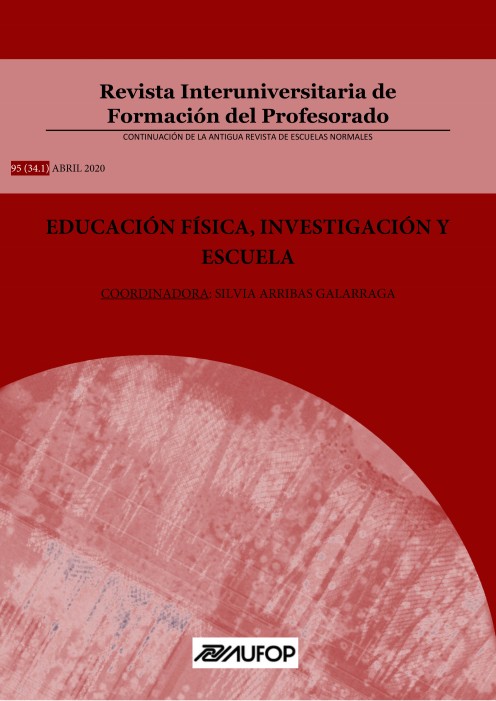Análisis inicial de la enseñanza del idioma español por medio de actividades deportivas en Varsovia (Polonia)
DOI:
https://doi.org/10.47553/rifop.v34i1.77851Resumen
El presente artículo muestra la metodología utilizada para la enseñanza del idioma español por medio de las actividades deportivas (Educación Física) en la escuela trilingüe de Varsovia (Polonia). En este estudio han participado 102 niños y niñas de 7 a 12 año cuyo profesorado de actividades deportivas es nativo español y desarrolla la material únicamente en dicho idioma. Los resultados muestran que en un periodo de entre 3 y 5 años el alumnado adquiere un nivel de español igual o superior al B1. Pese a que no se ha podido establecer relación entre el aprendizaje de actividades deportivas y el nivel lingüístico, atendiendo a los resultados académicos de quienes tienen un nivel bajo de español, el contexto de las actividades deportivas se vislumbra como favorable en el desarrollo de la competencia motriz.
Citas
Barajas, Y. (2013). Implementación de estrategias lúdicas para mejorar el desempeño escolar del área de matemáticas en los estudiantes de grado 6ºB del colegio Gimnasio el Bosque de la ciudad de San José de Cúcuta. Revista actividad física y desarrollo humano. 119-126.
Barron-Hauwaert, S. (2004). Language strategies for bilingual families: The one-parent-one-language approach (No. 7). Multilingual Matters
Bolaños, G. (1991). Educación por medio del movimiento y expresión corporal. San José, Costa Rica: Editorial EUNED.
Commission of the European Communities. (2003). Promoting language learning and linguistic diversity: An action plan 2004–2006.
Coyle, D. (2002). Relevance of CLIL to the European Commission Language Learning Objectives. In D. Marsh (Ed.), CLIL/EMILE European Dimension: Actions, Trends and Foresight Potential European Commission, Public Services Contract DG 3406/001-001.
Coyle, D., Hood, P., & Marsh, D. (2010). Content and language integrated learning. Ernst Klett Sprachen.
Cummins, J. 2002. Lenguaje, Poder y Pedagogía: Niños y Niñas Bilingües Entre Dos Fuegos. Madrid: Morata.
Dakowska, M. (1995). Models of language use and language learning in the theory of language didactics: Rozprawy Uniwersytetu Warszawskiego.
Dakowska (2007). Models of Language Learning and Language Use in the Theory of Language Didactics. Warsaw University Editions
Dakowska, M. (2011). Teaching English as a foreign language: A guide for professionals. Wydawnictwo Naukowe PWN.
Garc.a, E. 2005. Teaching and Learning in Two Languages. NY: Teachers College Press.
Garrido, R., Giménez, M., Gil, P., Luciañez, A. A., Rodríguez, M. E., Romero, B., Rubio, M., y Sánchez, J. M. (2010). Experiencia con la competencia matemática en la clase de educación física. Revista de Didácticas Específicas. (2), 83-99.
Genesee, F. (1999). Learning through Two Languages: Studies of Immersion and Bilingual Education. Cambridge, MA: Newbury House.
Gómez Muñiz, S. (2013). La teoría de las inteligencias múltiples aplicada a la enseñanza con metodología AICLE.
Grisolia, J. (2016). Interdisciplinariedad. Revista del Instituto de Estudios Interdisciplinarios en Derecho Social y Relaciones del Trabajo (IDEIDES). Rescatado http://revista-ideides.com/interdisciplinariedad/
Journal of the European Union Council Resultion of 21 November 2008 on a European Strategy for multilingualism (http://eur-lex.europa.eu/LexUriServ/Lez.do?uri=OJ:C:2008:320:0001:0003:EN:P:DF)
Marsh, D. (1994). Bilingual education & content and language integrated learning. International Association for Cross-cultural Communication (Eds.), Language Teaching in the Member States of the European Union (Lingua). Paris: University of Sorbonne.
McKay (2003) “The Cultural Basis of Teaching English as an International Language.Chilean Context. ELT Journal
McKay, S. L. (2012). Principles of Teaching English as an International Language: Sandra Lee McKay. In Principles and practices for teaching English as an international language (pp. 36-54). Routledge.
Ramos, F., y Ruíz Omenaca, J. V. (2011). La educación física en centros bilingües de primaria inglés-español: de las singularidades propias del área a la elaboración de propuestas didácticas prácticas con AIBLE. Revista española de lingüística aplicada, (24), 153-170.
Reloba, S., Chirosa, L. J., y Reigal, R. E. (2016). Relación entre actividad física, procesos cognitivos y rendimiento académico de escolares: revisión de la literatura actual. Revista andaluza de medicina del deporte, 9(4), 166-172.
Rodríguez, M. y Vega, J. (2004). Relación entre la edad, el nivel de práctica de actividad física y el funcionamiento cognitivo. Tesis Licenciatura en Ciencias del Deporte con énfasis en Salud. Escuela Ciencias del Deporte de la Universidad Nacional. Heredia, Costa Rica.
Vollmer, Helmut Johannes (2006b). “Language Across the Curriculum – Ways Towards Plurilingualism“. In: Martinyuk, Waldemar (ed.), Towards a Common European Framework of Reference for Language(s) of School Education. (Paper, presented at a conference in Kraków, 27-29 April 2006. Kraków: Jagellionian University. (to appear).
Woodburn, S. (1985). Desarrollo perceptual motor. Universidad Nacional. Heredia, Costa Rica: EUNA.
Descargas
Archivos adicionales
Publicado
Cómo citar
Número
Sección
Licencia
The "Revista Interuniversitaria de Formación del Profesorado (RIFOP)", with ISSN print 0213-8646 and ISSN electronic 2530-3791), adheres to the copyright notices proposed by Creative Commons
Authors’ rights
Papers published in the journal are subject to the following terms:
1. The Asociación Universitaria de Formación del Profesorado (AUFOP) is the editor of the RIFOP and holds the copyright of the papers published therein. The reuse of these is allowed under the license for use as indicated under point 2.
© Asociación Universitaria de Formación del Profesorado (AUFOP)
2. The papers are published in electronic version under the license CreativeCommons Reconocimiento-NoComercial-SinObraDerivada 3.0 España (texto legal). Papers can be copied, used, disseminated, transmitted and publicly exhibited provided that: i) the authorship and original publication source are cited (journal, editors and URL of the paper); ii) they are nit used for commercial gain; iii) the existence and specifications of the license for use are mentioned.
3. Auto-archiving conditions. Authors are allowed and encouraged to disseminate electronic pre-print versions (versions prior to peer review) and/or post-print (versions reviwed and accepted for publication) of their papers prior to their publication, since this favors prompt circulation and dissemination and supposes a possible increase in cites and scope within the academic community.
Privacy declaration
The names and email addresses incorporated into this journal will be used solely for the declared purposes of the journal and will not be available for any other purposes or to third parties.






